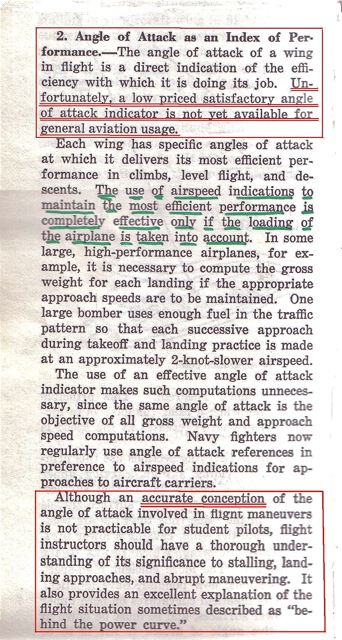Unanticipated stall/snaps at low levels above the ground are the killers. In what part of the fleet do these events occur?
Charter jets never get anywhere near the Angle of Attack limit in turns...the paying passengers don’t like steep banks; they are bad for business. But almost every charter jet aircraft is AoA equipped and V-speeds (all pre-computed) are the norm.
Low-level stall/spin incidents? Near Zero.
Heavy transport jetliners all use some variant of AoA, either displayed on the glare shield or deep in and part of the FMS system. Passenger comfort is also important. These pilots routinely operate only at low bank angles and lock in on pre-computed V-speeds.
Low-level stall/spin incidents? Near Zero.
Marine & Naval Aviators yank and bank daily and need to come back aboard ship with all excess energy off the aircraft, flying on the ragged edge of L/D…and EVERY Navy or Marine carrier-capable aircraft has AoA instrumentation.
Navy/Marine low-level stall/spin incidents? Near Zero.
Light General Aviation aircraft are very maneuverable and it’s much easier to get into a wind-blown too-steep bank on a too-tight turn from Base Leg to Final, etc. Very few aircraft carry AoA instrumentation.
Light General Aviation aircraft low-level stall/spin incidents? Far, far too many!
But, suppose you were looking outside and suddenly heard Slow Sarah saying "Getting Slow!" Reckon that might bring your eyes back inside to the Airspeed Indicator? We think so.
The FAA has known all this for decades. What has changed is the far lower cost of the modern electronics that can do the job. Here’s a clip from page 46 of Jim Osborn’s Flight Instructor's Handbook ( dated 1964 !! ) that I think you'll find interesting. Clearly, the FAA would have enthusiastically encouraged installing AoA instrumentation in training aircraft back then, but publicly lamented its affordability. (The underscores are Jim's; he was studying for his CFI rating).
Now, forty-six years later, the physics underlying that positive endorsement by the FAA remain equally valid...
...but the cost of a reliable AoA has plummeted.

FINALLY! A highly-accurate EARLY WARNING of STALL AoA system is available for well under $1,500
ACCIDENT FACTS
The Nall Report 2009 from the AOPA Air Safety Foundation indicates that in 2008, “Stall/Loss of Control” accidents account for over two thirds of all Maneuvering Accidents. Almost all occurred in very light aircraft (very few were retractable singles, none were twins) and the vast majority (75%) of the accidents were fatal. Total deaths were 45, plus eight seriously injured.
In Descent/Approach accidents, the same pattern holds true. A few retractable singles and twins were involved. 63% of “Stall/Spins” were fatal accidents, with a total of 25 deaths, plus four seriously injured.
So...
If an aviator …
• NEVER banks beyond 30-40 degrees, and
• NEVER has to carry widely-varying loads, and
• NEVER flies on days hotter than Standard Day, and
• NEVER lands above sea level, especially
• NEVER landing above 4,000 - 5,000 MSL, or
• NEVER flies into or out of minimum-length runways…
…then a normal Airspeed Indicator is just fine.
AoA gives a RELIABLE and VERY EARLY WARNING of STALL, which a traditional stall warning device can not provide. That’s the beauty of the Angle of Attack instrument.
But if you think it can't happen to you...then ask why it is that neither nor are sufficient in every case. Please consider these facts from the research:
" ....Pilots holding FAA Airline Transport Pilot (ATP) certificates are also less likely to stall/spin.
"That leaves pilots with FAA private and commercial pilot certificates in the 'most likely to suffer fatal stall/spin accidents' category. In fact, ..."
"An instructor on board is no guarantee. In reviewing 44 fatal stall/spin accidents from 1991 - 2000 and classified as instructional, ASF found that a shocking 91%(40) of them occurred during dual instruction, with only 9% (4) solo training flights...."
Click here to begin again with "Voices of those who know"
|






